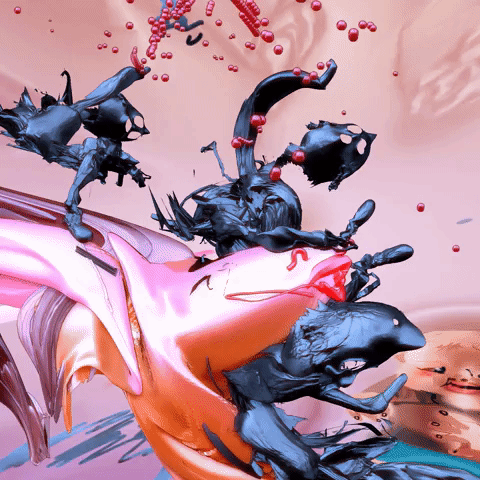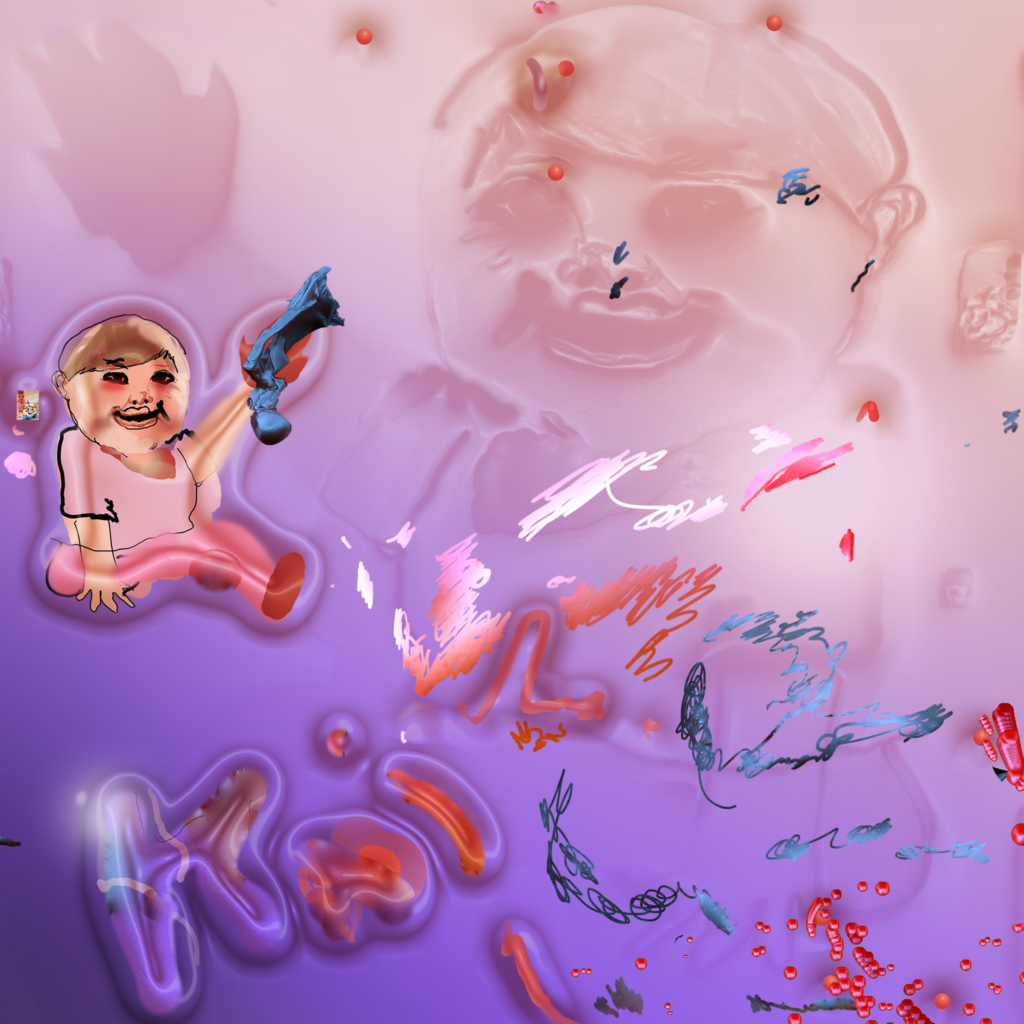“We are Hungry Hungry Caterpillars,” writes Kai Whiston in a three-way email conversation with AQNB and his visual collaborator Sam Rolfes. Whiston is the very young producer who, on releasing his Fissure Price EP via Big Dada Records on July 21, already has a very promising future. Not yet out of his teens and already on to his second extended-player since 2016’s Houndstooth came out on PBDY’s TAR label, there’s something about the gummy, crackling tangle of tactile sound that gives Dorset-based Whiston’s music an exhilarating sense of stringy overindulgence.

That’s why the pairing with New York-based Rolfes — who today premieres some 3D visual tasters with AQNB in advance of his collaborative live debut with Whiston at London’s Roundhouse on November 22 — is an ideal match. The Dallas-born digital artist’s equal parts crude and watery accumulation of maximalist pastiche complements the controlled chaos of Whiston’s Fissure Price, an EP that functions inside a knotted infinity of information. “I feel it’s the best way that I can incorporate and smash together everything that I like and see what sticks,” writes Whiston about the sheer access he’s grown up with, teaching himself music production on the internet, while mining its inexhaustible reservoir of material. “The almost absurd amount of content consumption has been a really core factor of my upbringing and I think that shows in my music.”
Rolfes brash and noisy, super-complex forms meet Whiston’s layers of emotional, historical and aural information. Their experience and creativity meets at the summit of an 18-year-old wunderkind who’s been ingesting and releasing (good) music since at least 16-years-old, more recently adding an Aristophanes貍貓 mixtape credit to his still fresh list of accomplishments. Rolfes has worked with Kingdom, Lunice and Rihanna. Both of them share an age-defying appreciation for everything audacious and unruly.
** Sam is also promoted as being important to the EP, how much do you each influence each other?
SR: Kai is the towering manifestation of the younger generation waiting for me to fall asleep long enough for him to devour me, and that anxiety is a brilliant motivation to create images to keep him entertained a few minutes longer.
Outside of that, we’ve found that the iterative, kinda expressionist way we throw together elements is very much in harmony, and that after our calls, the ideas that arise, whether of contorted plastic children’s’ toys or sonic car crashes, rattle around in my head for months after.

KW: Sam isn’t important at all, I’m just waiting to devour him in his sleep. Nah, but he is hugely important in all ways that he said. I’m very fortunate to have been jacking all of his shit for this long. A lot of what I do is interpretation of how I feel and what I see, with his visual stimuli and our conversations. I’m enjoying the time that I get to chat with him before he finds some smarter producer kid to talk to.
SR: * younger producer — aiming for a 12-year old next. ** How does the collaboration work, process-wise, and what similarities do you both see in how you approach your respective crafts? As I see it there’s a strong collage-y, slightly rough, punk element to how you both approach your use of sound and visuals.
SR: Kai, let me know if I’m wrong in this but I remember us having several conversations revolving around the idea of this kind of live, expressionist response to the material we’re collaging together and how we’re both formally working in a similar mode, improvisation-ally responding to the distortion feedback bouncing off our loose narrative walls. In terms of the collaboration process itself, I think it’s been fairly traditional thus far, with ideas and structural concepts being bounced back and forth — but, going forward, we’re going to be doing this in a much more literal, performative recreation of that on stage.
That said, it’s too disorienting to untangle ‘high’ versus ‘low’ at this point, with each plane of content sampling from each other (‘mainstream’ grabbing the ‘underground’ and the ‘underground’ defensively re-sampling with an ironic veneer, to give enough of an air gap to satisfy whatever virtue-signalling the underground scene has in place at the time). So the best thing I’ve found is to be as conversant in both contexts as possible, and figure out a way to create your work as best you can, while riding on top of the micro-scene turbulence.
KW: Yeah, whatever he said.
** Also, there’s a fashion element in what you do and who you work with; the interaction between fashion + art has been a complicated and ongoing one. Do you think this has had an effect on how you approach your work? Do you have any thoughts on how they work with and against each other?
SR: I think… for one, that it’s refreshing to work within the fashion industry, rather than the art world for commercial work because they’re far more honest with themselves about how contrived everything is than the art world is. They’re self aware that a lot of it is just about the party, the performance, the percussive self-serving exclamations of identity… and that not that many people really take the pseudo-anthropology draped over it all more seriously than considering it romantic marketing. That’s as opposed to the art world, which is seemingly very reliant on that to justify the existence of whatever precious lump is tacked in clusters inside white boxes this year.
The interaction of art, and fashion, and music is also a symbiotic one in that none seem to fully understand each other, but they’re both reliant on each other’s validation, to an extent. It’s also relevant and influential to my slow, ass-backwards progression towards theatrical, figurative performance, costume design, set design, etcetera, in my work. That said, working with musicians like Kai is often significantly more creatively supportive of experimentation than with a fashion brand.

** Kai, I’m curious about your approach to music-making. You and I are nearly 15 years apart, so I can’t assume anything in terms of where your perspective lies. How much do these two previous questions I sent to Sam about pop versus the underground, fashion and art, apply to the way you think about music, do you these ways of thinking about it even exist now?
KW: At the moment my work has been shameless escapism with the focus of building worlds and trying to dissociate the setting of my music to any real-world scenes or micro-genres; especially away from all that spooky industrial club shit that some people have grouped me in. I try and keep my reference to other music minimal with an intention of evoking a feeling more than making a song that sounds like a ‘____’ track.
I don’t have any insider information about the fashion and art industry, only the observation that those who distanced themselves the most from anything else in the least contrived way had the strongest impression on me. I’m still very — ‘y u n g’— in these departments and there’s still a lot I want to find out. I think my music could exist in the pop sphere because I think there’s a lot of weird kids like me that would dig it. I hope to be working in varying landscapes of formats and cultural planes in the future, as Sam is. I definitely don’t want anything in common with a lot of these ‘underground’ Evian Christ wannabe darktronica producers that love to comfortably exist in that bubble. The ones who want to be cool so badly that they sample everything in their mum’s shed with a 60 second reverb to impress all their very cool mates.
SR: Kai, play nice.
KW: Anyone noticed those weird trail things in the sky above Dalston? **















